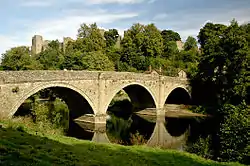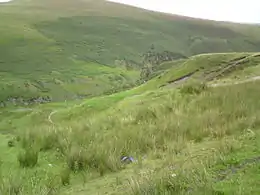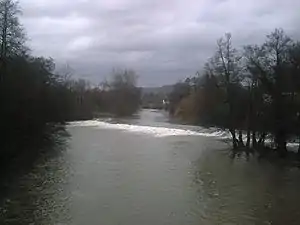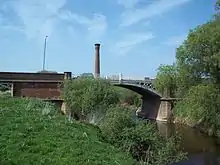River Teme
The River Teme (pronounced /tiːm/; Welsh: Afon Tefeidiad) rises in Mid Wales, south of Newtown, and flows southeast roughly forming the border between England and Wales for several miles through Knighton before becoming fully English in the vicinity of Bucknell and continuing east to Ludlow in Shropshire, then to the north of Tenbury Wells on the Shropshire/Worcestershire border there, on its way to join the River Severn south of Worcester. The whole of the River Teme was designated as an SSSI, by English Nature, in 1996.
| River Teme Welsh: Afon Tefeidiad | |
|---|---|
 The River Teme at Ludlow, Shropshire | |
| Location | |
| Country | Wales, England |
| Counties | Powys, Shropshire, Herefordshire, Worcestershire |
| Physical characteristics | |
| Source | Dolfor |
| • location | Kerry Hills, Radnorshire, Powys, Wales |
| • coordinates | 52°28′18″N 3°19′28″W |
| • elevation | 506 m (1,660 ft) |
| Mouth | Confluence with River Severn |
• location | Powick, Worcestershire, England |
• coordinates | 52°09′48″N 2°14′44″W |
• elevation | 14 m (46 ft) |
| Length | 130 km (81 mi) |
| Basin features | |
| Tributaries | |
| • left | River Clun, River Onny, River Corve, Ledwyche Brook, River Rea |
| • right | Leigh Brook, Kyre Brook |
The river is crossed by a number of historic bridges including one at Tenbury Wells that was rebuilt by Thomas Telford following flood damage in 1795.[1] It is also crossed, several times, by the Elan aqueduct.[2]
Etymology
The name Teme is similar to many other river names in England, testament to the name's ancient origin. Similar names include River Team, River Thames, River Thame, River Tame and River Tamar. Scholars now believe these names and the older names Temese and Tamesis derive from Brythonic Tamesa, possibly meaning 'the dark one'.[3]
Geography

The river source is in Mid Wales on the western side of Bryn Coch in the Kerry Hills near Dolfor, south of Newtown, Powys. Two other rivers - the River Ithon and the River Mule - rise within 500 metres. It is roughly coincident with the border between England and Wales for several miles downstream from the Powys village of Felindre, passing Beguildy, Lloyney and Knucklas on the Powys side and Llanfair Waterdine on the Shropshire side before flowing past the small Powys town of Knighton. It continues to shadow the border eastwards as far as the vicinity of Bucknell and Brampton Bryan. It is joined by the River Clun at Leintwardine in north Herefordshire then embarks on a circuitous course southeast then northeast to Bromfield where it is joined by the River Onny. From there to its confluence with the River Severn, at Worcester (about 40 miles/65 km downstream) it flows through the counties of Herefordshire, Shropshire and Worcestershire. The upper reaches of the river are usually steep with fast flowing but relatively shallow waters. There are some water mills, and a number of weirs, including several at the historic town of Ludlow. Below Tenbury Wells the river is more tranquil but still shallow, with strong cross currents. Water levels in the Teme are highly variable, something which has been made worse in recent years through increases in water extraction for agriculture use.[4]

During its journey the river flows over Upper Ludlow shales and Devonian sandstones.[5]
The River Corve flows into the Teme just outside Ludlow and the Ledwyche Brook flows into the Teme at Burford, close to the Herefordshire/Shropshire/Worcestershire tripoint. The Kyre Brook flows into the Teme at Tenbury Wells, and the River Rea flows into the Teme at Newnham Bridge, Worcestershire, a few miles south of Cleobury Mortimer, a small Shropshire town.
The river is the 16th longest river in the United Kingdom. It falls from a height of about 450 metres above sea level at its source[6] to just 14 metres above sea-level at its confluence with the River Severn.[7]
The Teme has in recent times often bursts its banks. June and July 2007 saw serious floods in a number of areas, including Leintwardine,[8] Tenbury Wells and Ludlow although the watercourse that flooded the last location was a tributary, the River Corve.[9] However, the upper reaches are also prone to drying out, noted by the Environment Agency to occur every three years in the past 20 years.[10]
Nature
The Teme is a clean river and after many years of decline the population of otters is recovering,[11] but obstructions keep salmon numbers at a low level.[12][13]
Recreational use
Fishing
Fishing is a popular sport on many parts of the River Teme, with its barbel fishing being particularly noted.[13][14]
Leisure boating

Leisure boats have long been used on the river and rowing boats can still be hired at The Linney Park, Ludlow.[15] An annual coracle regatta has been held on the Teme. In June 2005 it was held at Leintwardine. In June 2006, the 12th regatta was held at Mortimer's Cross.[16]
A Countryside Agency report in September 2003 entitled Improving access for canoeing on inland waterways: A study of the feasibility of access agreements stated:
There are no formal access agreements for canoeing on the Teme. However, unlawful canoeing does occur and there are many claims about the resulting conflict. As a result of its character, the demand for canoeing is seasonal, when there is enough water in the river, and is more in the upper reaches where the faster water can be found. However, this part of the river is also the most valuable for fishing, with riparian owners keen to protect their interests and prevent canoeing, on the grounds that the Teme is not suited to canoeing under any circumstances. While there is probably less conflict below Tenbury, there is also less interest in canoeing, and probably less opportunity, given the water levels.[4]
Information on canoeing on the Teme in the Ludlow area is available here[17] and on the Tenbury Wells to Broadwas area here.[18]
Leisure boating in the past
Historical evidence of leisure boating includes:
- Old maps show a few boat houses along the river in Worcestershire.[19]
- Billings Directory 1855 mentions Boat House, evidently a farmhouse, at Eastham (five miles downstream of Tenbury Wells).[20] Boat House Farm still exists at Eastham[21]
- The boathouse at Newnham Bridge (three miles downstream of Tenbury Wells) was large enough, and substantial enough, to be converted into a house.[22]
- At Tenbury Wells in 1886, people were rescued during floods using a boat that had broken loose from its mooring so there must have been at least one boat on the river at that time.[23]
- Down Along Temeside includes an account of travelling by boat from Ludford Mill to Orleton (a couple of miles upstream of Stanford Bridge) in the early 20th century.[24]
- Tenbury Wells and the Teme Valley includes a photograph taken at Little Hereford described as 'Boating on the Teme in 1905'. The author mentions two gentlemen from Oxford who in 1894 travelled up the Teme from Worcester to Ludlow in 17.5 hours, and returned (downstream) in 9 hours.[25]
Commercial navigation
Navigation to Powick Mill
The final 1.5 miles (2.4 km) from Powick bridge and Mill to its confluence with the river Severn that the Teme is (or was) navigable. There was a coal wharf near Powick Bridge, belonging with the mill, whose owner had the right to use a towing path to the river Severn. In the 18th century, pig iron was brought up the river to Powick forge (as the mill then was).[26] In 1810 it was reported that "The Teme is also navigable for barges from its junction with the Severn near Powick upwards to a small distance above Powick Bridge. The river having considerable declivity its navigation is soon interrupted by shoals and shallows"[27]
Above Powick Mill
Except for its lowest reaches, there is no substantial evidence that the river was navigable by barges. Claims have been made that traffic on the Teme began in Roman times and "continued in Norman times, when it is known the stone for the mill at Ashford Carbonel was brought from Caen in the 14th century, using water transport all the way".[28] However no unequivocal documentary or archaeological evidence has been adduced in support of this.
William Sandys who between 1636 and 1639 made the Avon navigable from Tewkesbury to Stratford-upon-Avon was at the same time also authorised to improve the Teme between Worcester and Ludlow. There is however no evidence that he did so, perhaps due to his having used up all his resources on the Avon. Having failed to recover the Avon after the Restoration, Sir William Sandys and his son undertook work on the Wye and Lugg.[29]
Ferries formerly existed at Rochford,[30] at Cotheridge[31] and at Clifton on Teme.[32] Some very local navigation is indicated by a newspaper advertisement in 1750 that the miller at Stanford-on-Teme had a boat for sale, capable of carrying 10 tons.[33] However, with no locks available, this vessel would have been unable to pass mill weirs.
Pictures, allegedly of Ludlow or its castle with a river and boats (thought to date from c. 1830), such as a painting allegedly of Dinham Bridge, Ludlow,[34] are probably at least partly derived from the artist's imagination.
This subject was debated at length in 2006 in the Journal of Railway and Canal Historical Society.[35][36]
Cultural influences
A.E. Housman wrote the following verse, which makes reference to the River Teme:
In valleys of springs of rivers
By Ony and Teme and Clun
The country for easy liversThe quietest under the sun
Settlements on the River Teme
- (source)
- Felindre
- Beguildy
- Llanfair Waterdine
- Knucklas
- Knighton, Powys
- Bucknell
- Brampton Bryan
- Leintwardine
- Burrington
- Bromfield
- Ludlow
- Ashford Bowdler
- Ashford Carbonel
- Little Hereford
- Tenbury Wells
- Knighton-on-Teme
- Lower Rochford
- Newnham Bridge
- Eastham
- Eardiston
- Stockton-on-Teme
- Stanford Bridge
- Shelsley Walsh
- Shelsley Beauchamp
- Clifton-upon-Teme
- Whitbourne
- Martley
- Knightwick
- Broadwas
- Lulsley
- Cotheridge
- Leigh
- Bransford
- Powick
- Worcester
References
- Teme Valley Times, Spring 2007, p2
- Bing aerial imagery; OpenStreetMap
- Ekwall, E., English Place-Names (4th ed), OUP, 1960, ISBN 0-19-869103-3, pp 459, 463, 464
- Wendy Thompson Improving access for canoeing on inland waterways: A study of the feasibility of access agreements for the Countryside Agency September 2003
- The Teme Valley a blog on the Herfordshre & Worcestershire Earth Heritage Trust website
- "Bing maps (Ordnance Survey)". Retrieved 3 August 2020.
- Ordnance Survey: Worcester & Droitwich Spa
- YouTube - video of flooding
- Ludlow Advertiser
- https://www.bbc.co.uk/news/uk-england-hereford-worcester-44722945
- S. M. Macdonald, C. F. Mason, I. S. Coghill The Otter and Its Conservation in the River Teme Catchment The Journal of Applied Ecology, Vol. 15, No. 2 (Aug., 1978), pp. 373-384 doi:10.2307/2402597
- Local Environment Focus: Focus Local environmental issues in Bishop's Castle, Church Stretton, Craven Arms, Knighton, Ludlow, Cleobury Mortimer, Tenbury Wells, Whitbourne, Colwall and Worcester | issue 2. This citation needs a page number
- Tales From The Teme Bloor's Barbel Bulletin - December 2001
- Tenbury Wells and the Teme Valley, 2007, p2
- Ludlow "England's finest market town" - Country Life
- Leintwardine Coracle Society Annual Regatta
- http://www.ukriversguidebook.co.uk/midengland/teme.htm
- http://www.ukriversguidebook.co.uk/midengland/temetenbury.htm
- Ordnance Survey, six-inch maps (1st edition), various: accessible at www.old-maps.co.uk.
- Billings Directory lists "Eckley Vincent, farmer, Boat House" at Eastham in 1855.
- Internal framing of barn at Boat House farm, Eastham, Worcestershire
- Northern Area Development Control Committee Minutes of the Malvern Hills District Council, 6 October 2004.
- F. Wayland Joyce, Tenbury - Some Record of its History (1931)
- Richard Holding, Down Along Temeside (1963).
- Howard Miller, Tenbury Wells and the Teme Valley (1996).
- H. Lloyd, The Quaker Lloyds in the Industrial Revolution (1975), 148-50.
- William Pitt, A General View of the Agriculture of the County of Worcester With Observations on the Means of Its Improvement (Board of Agriculture, Great Britain)
- Colin Green. Severn Traders, Black Dwarf Publications (1999), ISBN 0-9533028-2-2. p.33.
- I. Cohen 'The non-tidal Wye and its navigation' Transactions of the Woolhope Naturalists Field Club 34 (1955), 83-101; P. King, 'The River Teme and Other Midlands Navigations' Journal of Railway and Canal Historical Society 35(5) (July 2006), 350-1.
- A History of the County of Worcester: volume 4: 'Parishes: Rochford' (1924), pp. 317-19. Date accessed: 29 May 2007.
- A History of the County of Worcester: volume 4: 'Parishes: Cotheridge' (1924), pp. 255-60. Date accessed: 29 May 2007.
- A History of the County of Worcester: volume 4: 'Parishes: Clifton upon Teme' (1924), pp. 246-55. Date accessed: 29 May 2007.
- C. Hadfield, Canals of the West Midlands (1969), 58-9.
- "1840s painting of river Teme at Ludlow". Retrieved April 2015. Check date values in:
|access-date=(help) "This painting of Dinham Bridge showing six Severn Trows moored and a square rigged boat sailing upstream below the Castle must have been produced before 1823 as this was when the multi arched bridge was demolished and the present bridge built. The trows on the right are unloading wheat and taking on board bags of flour." "Painting of Worcestershire". WorcesterVista.com. Retrieved April 2015. Check date values in:|access-date=(help) - Pat Jones 'Navigation on the river Teme' Journal of Railway and Canal Historical Society 35(4) (March 2006), 293-300.
- Peter King 'The River Teme and Other Midland Navigations' Journal of Railway and Canal Historical Society 35(5) (July 2006), 348-55. Correspondence about this also appears in the two subsequent issues.
Further reading
External links
| Wikimedia Commons has media related to River Teme. |
- Teme valley project
- Teme Valley towns
- Teme Valley Times (local paper)
- Picture at Geograph (search the site for others)

